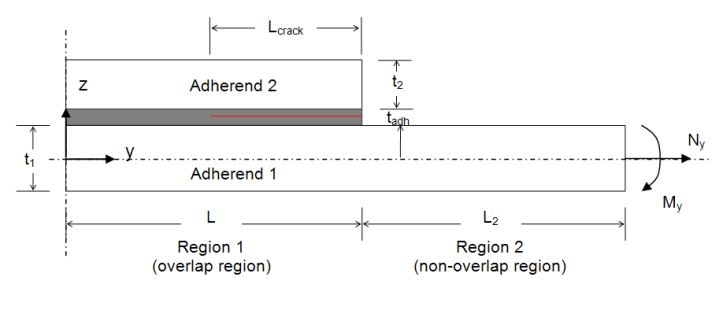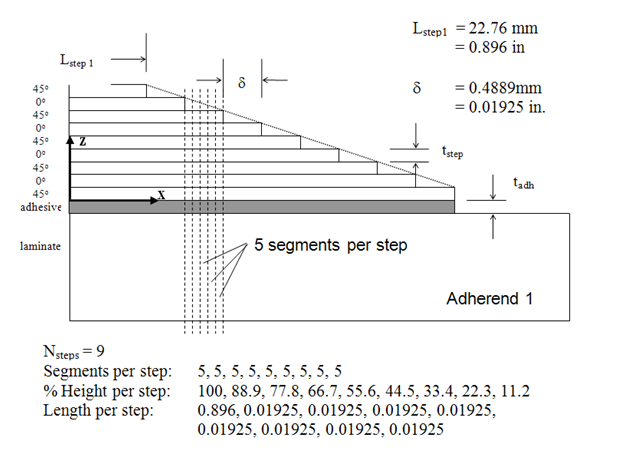
HyperSizer performs bonded joint analysis at the bond line of stiffened panels between the flange and facesheet. This analysis is performed automatically by activating the Joint Failure Analyses on the Failure tab. The backdoor settings presented below provide refined control over the bonded joint analysis.


Bonded Doubler Joint Analysis (Default = True)
Flag to turn on/off bonded joint analysis.
Bonded Doubler Display Plots (Default = False)
Flag to turn on/off bonded joint stress plots that appear at the end of a HyperSizer analysis.
Bonded Doubler Metric Unit Plots (Default = False)
If False, units of bonded joint stress plots are in psi.
If True, units of bonded joint stress plots are mm, MPa.
Bonded Doubler Segments1 (Default = 8)
Number of segments in Region 1 (overlap region).
Bonded Doubler Segments2 (Default = 5)
Number of segments in Region 2 (non-overlap region).
Bonded Doubler Points per segment (Default = 5)
Number of analysis points per segment in the y direction. This setting controls the fineness of the bonded joint analysis. The total number of analysis points is (NSeg) x (Number of y points) x (Number of z points). HyperSizer performs failure analysis at every analysis point. More analysis points will give more refined results, but will increase run time.
Bonded Doubler w or Qy (Default = 2)
Value = 1, a boundary condition of w = 0 (pinned) is imposed on the right edge of Region 2.
Value = 2, the shear force, Qy, from the Sizing form, FBD tab, is imposed on the right edge of Region 2.
Bonded Doubler Beta or My (Default = 1)
Value = 1, a zero curvature (beta = 0) is imposed on the right edge of Region 2.
Value = 2, the bending moment, My, from the Sizing form, FBD tab, is imposed on the right edge of Region 2.
Number of Z points per ply (Default = 5)
Number of analysis points per ply in the z direction. This setting controls the fineness of the bonded joint analysis. The total number of analysis points is (NSeg) x (Number of y points) x (Number of z points). HyperSizer performs failure analysis at every analysis point. More analysis points will give more refined results, but will increase run time.
Number of Steps in doubler (Default = 1)
For a stepped bonded doubler, following are the number of steps. For a non-stepped doubler, enter 1 and ignore the next three entries.
The figure shown below applies to stepped bonded doubler joints; there are nine steps in this example.

Bonded Doubler Segments per Step (Default = N/A)
If their is only one step, this setting is ignored. If the number of steps is greater than one, this is the number of segments for each step. The segments should be entered as a comma-separated list and the number of entries must match the number of steps. In the example shown, the segments per step would be entered as "5, 5, 5, 5, 5, 5, 5, 5, 5" (excluding the quotes).
Bonded Doubler % Height per Step (Default = N/A)
If their is only one step, this setting is ignored. If the number of steps is greater than one, this is the percent height for each step. The thicknesses should be entered as a comma-separated list and the number of entries must match the number of steps. A value of 100% indicates full thickness for Adherend 2. The first step should always have a thickness = 100%. The thickness of all steps will be rounded to the nearest full ply thickness.
For the nine-ply layup shown above, each step is dropping one ply (11.1%), therefore the thickness percentages are "100, 88.9, 77.8, 66.7, 55.6, 44.5, 33.4, 22.3, 11.2" (excluding the quotes).
Bonded Doubler Length per Step (Default = N/A)
If their is only one step, this setting is ignored. If the number of steps is greater than one, this is the length of each step. The length should be entered as a comma-separated list and the number of entries must match the number of steps. Lengths must be entered in inches.
For the nine-ply layup shown above, the lengths are entered as "0.896, 0.01925, 0.01925, 0.01925, 0.01925, 0.01925, 0.01925, 0.01925, 0.01925" (excluding the quotes).
Bonded Doubler Adhesive E (Default = 445,000 psi)
If an adhesive layer is included in the bonded combo flange object (Adherend 2) laminate, this setting is ignored. If no adhesive layer is included, the bonded joint code will use this value as the adhesive modulus of elasticity. This value must be entered in psi.
Bonded Doubler Adhesive G (Default = 165,000 psi)
If an adhesive layer is included in the bonded combo flange object (Adherend 2) laminate, this setting is ignored. If no adhesive layer is included, the bonded joint analysis will use this value as the adhesive shear modulus. This value must be entered in psi.
Bonded Doubler Adhesive CTE (Default = 98.0D-6 in/in/°F)
If an adhesive layer is included in the bonded combo flange object (Adherend 2) laminate, this setting is ignored. If no adhesive layer is included, the bonded joint analysis will use this value as the adhesive coefficient of thermal expansion. This value must be entered in in/in/°F.
Bonded Doubler Adhesive Thickness (Default = 0.004 inches)
If an adhesive layer is included in the bonded combo flange object (Adherend 2) laminate, this setting is ignored. If no adhesive layer is included, the bonded joint analysis will use this value as the adhesive thickness. This value must be entered in inches.
Bonded Doubler Bondjo Output File (Default = False)
If this flag is set to True, several detailed reports will be generated for the joint in the "C:\" root location. This option slows execution significantly. If you do not have write access to the root of the C:\ Drive, setting this option to True will result in a run-time error.
Bonded Doubler Number of Zplots (Default = 0)
Number of vertical cut plots through the thickness of the joint. HyperSizer will generate cross-section stress plots at each vertical cut.
Location of Z Cuts (Default = N/A)
Location of vertical cuts, measured from the origin (left edge) of the joint. The locations must be entered as a comma-separated list (e.g. "0.1, 0.1" excluding the quotes). The number of locations must match the number of Zplots (above). The locations must be within the joint area (between the left and right edges). Locations outside the joint area will be ignored. The locations must be entered in inches.
Bonded Doubler Number of Xplots (Default = 0)
Number of horizontal cut planes through the thickness of the joint. HyperSizer will generate cross-section stress plots at each horizontal cut.
Location of X Cuts (Default = N/A)
Location of horizontal cuts, measured from the origin (midplane of Adherend 1) of the joint. The locations must be entered as a comma-separated list (e.g. "0.1, 0.1" excluding the quotes). The number of locations must match the number of Zplots (above). The locations must be within the joint area (between the left and right edges). Locations outside the joint area will be ignored. The locations must be entered in inches.
Bonded Doubler Linear (Default = False)
If True, HyperSizer will treat the adhesive as linear. If False, the adhesive will be treated as non-linear using Ramberg-Osgood parameters entered on the adhesive isotropic material. If these parameters are not available on the isotropic material, a run-time error will occur. Since the non-linear analysis is repetitive, this option can slow the analysis down substantially.
Non-Linear Iteration Tolerance (Default = 0.02)
Dictates convergence tolerance for non-linear iterations.
VCCT Crack Analysis (Default = False)
True to introduce a "crack" in the adhesive at the right free edge and perform the Virtual Crack Closure Technique (VCCT) analysis to determine the Strain Energy Release Rate (SERR).
VCCT Crack Length (Default = False)
Length of crack for VCCT. Note, this length must correspond to a segment boundary; if not, the length will be rounded up to the next segment boundary.
